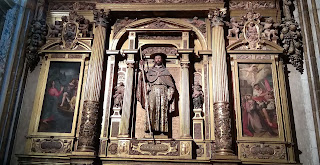Today is the feast of Saint James the Elder, one of Christ's apostles. According to the legend that solidified at the turn of the eleventh century - and that was later popularised through Legenda Aurea - James was beheaded in Judea, whereupon his disciples brought his body with them in a rudderless boat which God directed to Galicia, where James was eventually buried on July 25. This legend is the kernel of the cult of Saint James, or Santiago, at Compostela, and it was elaborated through the composition of Liber Sancti Iacobi, the Book of Saint James, early in the twelfth century.
Through the legend of Santiago, the apostle's saintly personality was elaborated and accrued more layers. From being an apostle preaching in Judea, he also became the apostle of Spain, a pilgrim, and a battle-helper, who could be called upon to assist in vanquishing enemies. This latter feature is a very common aspect of several saints, but in the case of Santiago this feature has become dominant. In the course of the conflicts between the Christian kingdoms and the Muslim leaders on the Iberian peninsula, Santiago developed into the figure of Santiago Matamoros, the Moor-killer, and he was very popular among knights and soldiers.
Altarpiece for the chapel of Saint James the Elder, 1591
Cathedral of Segovia
The development of the legend of Santiago shows how malleable the stories about the saints could be, and the historical evolution of the figure of Santiago is eminently well summarised in an altarpiece in the cathedral of Segovia. The altarpiece is situated in the chapel of Saint James. The altarpiece itself was made in 1591 by Pedro de Bolduque, while the depictions of Santiago as a pilgrim and the translation of his body were executed by Orazio Castellino. From bottom to top, we see here the iconographical development of Santiago, meaning that his entire legend is summarised elegantly in one framework comprised of three layered elements. In this way, the altarpiece shows how compressed the representations of saints' legends could be, and how efficiently church art could convey and remind the viewers of the complex and at times lengthy stories of the saints.
The bottom, the beginning and root of the cult, as it were, shows the translation of James' relics to his Galician resting place. This shows James the Apostle, the first configuration of Santiago.
We then see James the pilgrim, dressed in the cloak and hat emblematic of the pilgrim, and carrying the pilgrim's staff, signifying the numerous pilgrims that flocked to his alleged tomb from all over Latin Christendom. This is the second configuration of Santiago.
And on the top we see the last configuration, which is perhaps also the most visible configuration in Spanish iconography, namely Santiago Matamoros. This is the latest offshoot of the legend, and due to its dominating position in Spanish history, it is also fitting to see this configuration presiding at the top of the altarpiece.
The legend of Santiago shows better than most legends how saints keep evolving in the traditions of their venerators, and the custodians of their cult centres. This blogpost serves merely as a very cursory overview of the matter, but there are many and exciting layers of historical accretions to dig through in order to follow this development in its details.




Ingen kommentarer:
Legg inn en kommentar